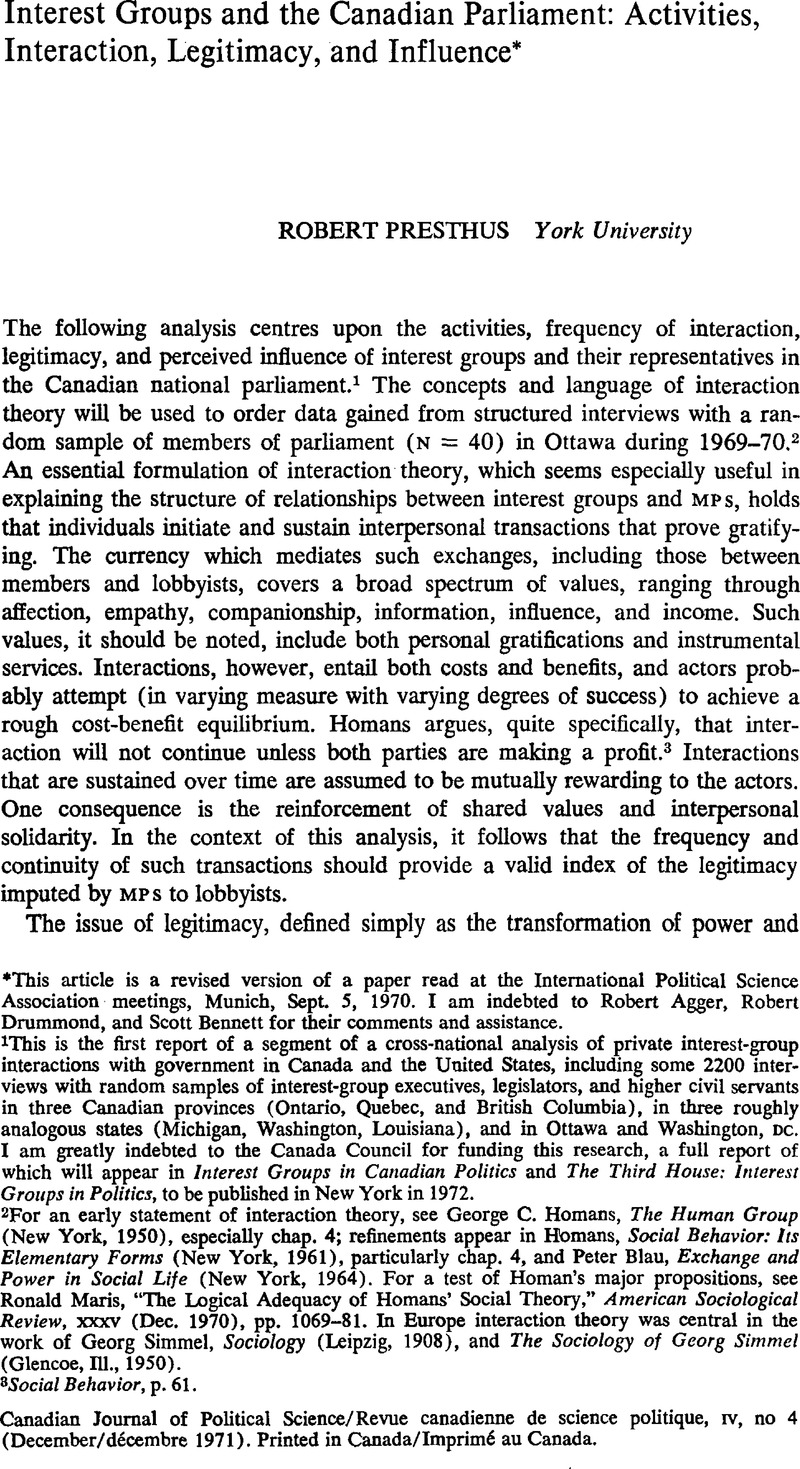Published online by Cambridge University Press: 10 November 2009

1 This is the first report of a segment of a cross-national analysis of private interest-group interactions with government in Canada and the United States, including some 2200 interviews with random samples of interest-group executives, legislators, and higher civil servants in three Canadian provinces (Ontario, Quebec, and British Columbia), in three roughly analogous states (Michigan, Washington, Louisiana), and in Ottawa and Washington, DC. I am greatly indebted to the Canada Council for funding this research, a full report of which will appear in Interest Groups in Canadian Politics and The Third House: Interest Groups in Politics, to be published in New York in 1972.
2 For an early statement of interaction theory, see Homans, George C., The Human Group (New York, 1950)Google Scholar, especially chap. 4; refinements appear in Homans, , Social Behavior: Its Elementary Forms (New York, 1961)Google Scholar, particularly chap. 4, and Blau, Peter, Exchange and Power in Social Life (New York, 1964).Google Scholar For a test of Homan's major propositions, see Mans, Ronald, “The Logical Adequacy of Homans’ Social Theory,” American Sociological Review, xxxv (Dec. 1970), pp. 1069–81.Google Scholar In Europe interaction theory was central in the work of Simmel, Georg, Sociology (Leipzig, 1908)Google Scholar, and The Sociology of Georg Simmel (Glencoe, Ill., 1950).
3 Social Behavior, p. 61.
4 Although on the whole it seems to be less characteristic, such deference appears in the United States as well. For evidence at the community level, see Presthus, Robert, Men at the Top: A Study in Community Power (New York, 1964).Google Scholar There, the community which was most homogeneous in socio-economic and ethnic composition tended to exhibit more deferential patterns of political attitudes and interaction, compared with a second community which was highly differentiated along these lines. The explanation seems to be that homogeneity provides a Gemeinschaft basis for mass trust in leaders and attending delegation of decision-making to them. In the past, the hegemony of British cultural norms may have accounted for the deferential style of Canadian politics.
5 One notes, for example, that the leading text in the field, Dawson, R. MacGregor, The Government of Canada, revised by Ward, Norman (5th ed., Toronto, 1970)Google Scholar, does not include in the index or the table of contents the terms “interest groups,” “pressure groups,” or “lobbying.”
6 In deference to some ambivalent responses to the terms “lobbyist” and “lobbying” during the pretesting of our Canadian interview schedules, we occasionally substituted the euphemism “interest-group representative” for the term “lobbyist.” As the research proceeded, however, we found that both the terminology and the activity commonly known as “lobbying” were operationally relevant in the Canadian milieu. The study also raised a question as to the relationship between the roles of the executive director of an interest group and a “lobbyist.” Our research indicates that there is no uniform practice, but that permanent interest-group executives often spent part of their work time interacting with legislators and higher bureaucrats. Some refer to themselves as “lobbyists,” while others indicate that their organization employs a “legislative representative” who specializes in such a role.
7 “Interest groups” are defined broadly to include any private, non-profit group, with a permanent executive director, an office, and a telephone. Our Ottawa sample, for example, included the following types of groups, selected from a universe drawn randomly from current telephone directories:

8 The item used here was: “As a legislator, you represent a variety of constituencies. Please rank three of the following in terms of their importance to you as a representative.”
9 Bilingualism and Biculturalism in the Canadian House of Commons (Ottawa, 1970), pp 66–9; 77–80.
10 “Politics as a Vocation,” in Gerth, H. and Mills, C., From Max Weber: Essays in Sociology (New York, 1946), pp. 86–8.Google Scholar Such a generalization must, however, be qualified in the Canadian milieu where politics (and perhaps administration) retain substantial residues of amateurism. As Kornberg, Allan found, turnover in the Canada federal lower House in 1962 was about 40 per cent. Canadian Legislative Behavior (New York, 1967), p. 38.Google Scholar Cf. Porter, John, The Vertical Mosaic: An Analysis of Social Class and Power in Canada (Toronto, 1965)CrossRefGoogle Scholar, who speaks of “the practice of avocational politics, where a stint in politics is an interstitial stage in a career devoted to something else,” pp. 402, 398–415. On the other hand, Hoffman and Ward found (1965) that almost all the MPS in their sample planned to run again, mainly because they “liked the job” (42 per cent), “wanted to finish the job” (29 per cent), or “wanted to continue serving the public” (25 per cent). Bilingualism and Biculturalism, p. 123. Although my own research (1969) did not include this item, among backbenchers at least a certain amount of disenchantment became evident, which would seem to support the “high turnover” interpretation.
11 Canada, Committee on Election Expenses, Studies in Canadian Party Finance (Ottawa, 1966)Google Scholar, see especially pp. 232–78.
12 The Human Group, p. 43. Homans recognizes that interaction can also inspire negative affects.
13 The “medium” and “low” data are not presented here, mainly because our principal interest is in the “high” level and because the NS at the “low” interaction level total only 9.